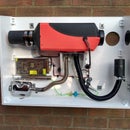Introduction: Myford ML10 Lathe Indexing Jig Dividing Head
This is not a precision indexing head and it is not able to precisely work to thousandths of an inch.
It cost well under £5 and will serve my needs for for tasks such as placing equally spaced cross-drilled holes or scribing graduated lines. It might be able to work to a precision of 0.1mm (on a good day)?
It is based on an ebay indexing disc, bought for £2.98 (Oct 2020), a few M6 nuts and bolts (or threaded rod) and three 3D printed parts.
It is designed to suit my Myford ML10 lathe but the concept could easily be transferred to other small lathes.
The Sketchup design file and the STLs needed, are available in the final step.
The indexing disc has three sets of holes (36, 40 and 48) and is available from many ebay sources.
The sets of holes enable many common divisions to be achieved.
36 holes can divide into 2, 3, 4, 6, 9, 12, 18 divisions
40 holes can divide into 2, 4, 5, 8, 10, 20 divisions
48 holes can divide into 2, 4, 6, 8, 12, 16, 24 divisions
The disc holes cannot support 7, 11, 13, 14, 15, 17, 19, 21, 22, 23 or above divisions. (100 divisions would be nice for creating dials - it would not be impossible to produce a 3D-printed disc with 100 holes).
Step 1: 3D Printed Parts
There are three main 3D-printed parts which were printed with 30% infill and a 0.15mm layer height.
The disc holder part (blue) slides into the spindle of the lathe and is expanded by an aluminium wedge (pulled into the slotted end) to clamp it into the spindle. It is possible that a 3d-printed part could have been used for the wedge, but having a lathe, it was simple to make it in aluminium, and it slides in effortlessly to do its job.
The three M6 nuts are held by cutouts in the arm (green) and main clamp.
Had the expanding-tube/tapered-plug arrangement for securing the disc to the spindle not worked, a socket - capable of sliding over the 25 tooth spindle gear - would have been tried instead. It would probably not have had any internal gear-teeth formed (maybe just one ridge to stop it sliding) and some sort of clamping arrangement organised.
An MP4 animation of the Sketchup design is available below.
Attachments
Step 2: Remaining Parts
The photographs show the remaining parts. All the main threaded parts are M6. Two M4 nuts and bolts were used to hold the disc onto the 3D print - if this ever slips, some super-glue will keep it firm.
The aluminium cone is made from 1/2" aluminium bar. One end is 12.5mm (1/2"), the other is 9mm (to fit inside the 10mm bore of the disc holder). The length of the tapered part is 21mm - this is not critical and it could be longer. Again, this was cut on the lathe with the cross-slide set to 5º - it seems to work well.
The long M6 screw had a wing-nut welded onto the end, but could be a simple hex-head bolt, etc
The locating pin is made from brass, to avoid wear on the disc-holes. The tip has a slight taper (cross-slide set to 5º angle) to locate perfectly into the holes in the disc. It was made from 1/4" brass bar and a tab was soldered into the end to make it easier to locate. A spindle handle was used to cut the thread:
Step 3: Fitting Onto the Lathe
The system used is pretty flexible and the dimensions are not super-critical, except the size of the square hole which clamps the whole assembly to the lathe. This is only slightly bigger than the square stub on the lathe, to it only needs a little bit of clamping force to secure the assembly.
In use, the main clamp is slid loosely onto the square stub, then the disc assembly is slid into the spindle and tightened (pull on the wing-nut to force the tapered plug into the plastic, tighten the wing-nut until the disc is locked in). The main clamp is tightened and the swinging arm adjusted to locate the pin over the appropriate ring of holes, and the arm is tightened down to the main clamp.
Whilst testing, the disc assembly and the main clamping piece stayed rock solid, without slipping.
Step 4: Results
A few tests were done. The photo shows one test piece with 10 lines scored on a waste piece of aluminium. It worked well for my purpose.
There was little play in the system - the worst play was caused by the fit of the brass locating pin in the captive nut. Some wobble was visible, which permitted a slight rotation of the disc - and hence the part being held in the chuck. A spring-loaded pin was considered, but the path of least resistance was taken with this simple (if slightly flawed) solution. A reamed brass insert holding a precision-turned locating pin could eliminate this source of error.
A tool post drill is ideal for use with this. See my Instructable for a 3-D printed toolpost drill:
https://www.instructables.com/3d-Printed-Lathe-Too...
Step 5: Files
The Sketchup 2017 file ML10 lathe indexing 04.skp
STL file for the disc holder Disc holder.stl
STL file for the main clamp Clamp v 2.stl
STL file for the arm arm.stl


















